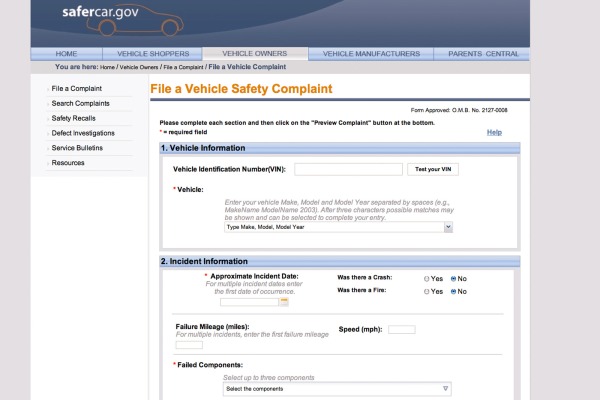
Vehicle manufacturers can voluntarily issue recalls, or the National Highway Traffic Safety Administration (NHTSA) can order them. Most car recalls are termed "voluntary" manufacturer recalls, but many have been prompted by NHTSA's decision to investigate consumer complaints.
Voluntary or not, almost all car recalls are prompted by complaints that consumers make to the manufacturers or to NHTSA's Office of Defects Investigation (ODI). Consumer advocates say that filing a complaint with ODI is the most effective way to ensure the matter is investigated. The process also is fairly easy. NHTSA even has an online form that allows consumers to write and file a report in just minutes.
If consumers file a sufficient number of complaints, or if a few complaints indicate a significant safety issue, NHTSA can take a series of investigative steps that can lead to a recall order. Edmunds.com outlines the process in "A Quick Guide to Recalls."
Once NHTSA has determined the need for a car recall, federal law requires manufacturers to notify all registered owners and purchasers of the affected vehicles by registered mail. The notice must explain the potential safety hazards presented by the problem and instruct consumers on how to get the problem corrected. It also must inform consumers that the repairs are to be made at no charge and tell them when the fix will be available, how long it will take to perform and who to contact if there is a problem in obtaining the free recall work.
Almost all recalls are publicized via media releases from both NHTSA and the manufacturer. These releases go out weeks or even months before the manufacturer mails the individual owner notices. The media outreach is another effort to make sure that consumers whose mailing addresses might not be up to date know about recalls. Edmunds reports on major recalls weekly in its Car News section.
Sometimes, consumers get problems fixed and pay for the repairs before a manufacturer announces a recall. In most cases, if such consumers can present proper receipts, the automaker is required to provide reimbursement once a safety recall is issued. Usually, manufacturers are required to pay for safety-related repairs that were completed up to one year before the recall.
But if NHTSA opened what's called a formal "engineering analysis" more than a year prior to the recall, then the date on which that analysis was opened is the beginning of the term for eligible compensation.
While car recalls don't have an expiration date, they are only enforced for "reasonable periods," the agency says. Basically, a recall is over if a vehicle's manufacturer goes out of business, or if the parts needed to make the necessary repair are no longer being made.
NHTSA requires manufacturers to file quarterly progress reports showing how many of the affected vehicles have been inspected, how many were repaired and how many owners haven't been reached. In cases where the agency determines that additional efforts to notify owners are needed, it can ask the manufacturer to send another round of letters. Many manufacturers voluntarily go far beyond that and use annual DMV registration lists acquired from two data companies, Polk and Equifax, to continue searching for vehicles that haven't had the appropriate repairs. Spokesmen for both Honda and Toyota said their companies in some cases have even set up phone banks to call owners of vehicles involved in recalls.
The safety agency also has launched a new recall lookup tool that enables consumers to find open recalls on individual vehicles sold since 1999 using the vehicle identification number, or VIN.
There is a limit on how far back a manufacturer has to go to fix problems without charging the owner. Vehicles eligible for no-cost repair can't be more than 10 years old as of the date the defect was determined. So a recall ordered this year would only reach back to cars sold new from 2003 onward. There is a more complete list of rules on NHTSA's recall process site.